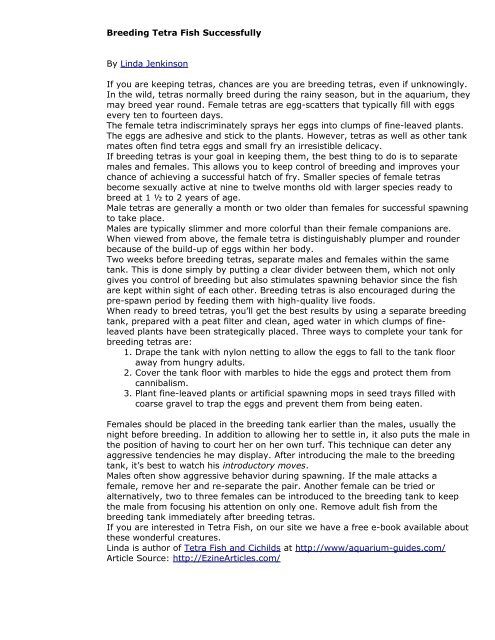PetFish.Net Guide - Barbs, Tetras And Minnows
PetFish.Net Guide - Barbs, Tetras And Minnows
PetFish.Net Guide - Barbs, Tetras And Minnows
Create successful ePaper yourself
Turn your PDF publications into a flip-book with our unique Google optimized e-Paper software.
Breeding Tetra Fish Successfully<br />
By Linda Jenkinson<br />
If you are keeping tetras, chances are you are breeding tetras, even if unknowingly.<br />
In the wild, tetras normally breed during the rainy season, but in the aquarium, they<br />
may breed year round. Female tetras are egg-scatters that typically fill with eggs<br />
every ten to fourteen days.<br />
The female tetra indiscriminately sprays her eggs into clumps of fine-leaved plants.<br />
The eggs are adhesive and stick to the plants. However, tetras as well as other tank<br />
mates often find tetra eggs and small fry an irresistible delicacy.<br />
If breeding tetras is your goal in keeping them, the best thing to do is to separate<br />
males and females. This allows you to keep control of breeding and improves your<br />
chance of achieving a successful hatch of fry. Smaller species of female tetras<br />
become sexually active at nine to twelve months old with larger species ready to<br />
breed at 1 ½ to 2 years of age.<br />
Male tetras are generally a month or two older than females for successful spawning<br />
to take place.<br />
Males are typically slimmer and more colorful than their female companions are.<br />
When viewed from above, the female tetra is distinguishably plumper and rounder<br />
because of the build-up of eggs within her body.<br />
Two weeks before breeding tetras, separate males and females within the same<br />
tank. This is done simply by putting a clear divider between them, which not only<br />
gives you control of breeding but also stimulates spawning behavior since the fish<br />
are kept within sight of each other. Breeding tetras is also encouraged during the<br />
pre-spawn period by feeding them with high-quality live foods.<br />
When ready to breed tetras, you’ll get the best results by using a separate breeding<br />
tank, prepared with a peat filter and clean, aged water in which clumps of fineleaved<br />
plants have been strategically placed. Three ways to complete your tank for<br />
breeding tetras are:<br />
1. Drape the tank with nylon netting to allow the eggs to fall to the tank floor<br />
away from hungry adults.<br />
2. Cover the tank floor with marbles to hide the eggs and protect them from<br />
cannibalism.<br />
3. Plant fine-leaved plants or artificial spawning mops in seed trays filled with<br />
coarse gravel to trap the eggs and prevent them from being eaten.<br />
Females should be placed in the breeding tank earlier than the males, usually the<br />
night before breeding. In addition to allowing her to settle in, it also puts the male in<br />
the position of having to court her on her own turf. This technique can deter any<br />
aggressive tendencies he may display. After introducing the male to the breeding<br />
tank, it’s best to watch his introductory moves.<br />
Males often show aggressive behavior during spawning. If the male attacks a<br />
female, remove her and re-separate the pair. Another female can be tried or<br />
alternatively, two to three females can be introduced to the breeding tank to keep<br />
the male from focusing his attention on only one. Remove adult fish from the<br />
breeding tank immediately after breeding tetras.<br />
If you are interested in Tetra Fish, on our site we have a free e-book available about<br />
these wonderful creatures.<br />
Linda is author of Tetra Fish and Cichilds at http://www/aquarium-guides.com/<br />
Article Source: http://EzineArticles.com/


